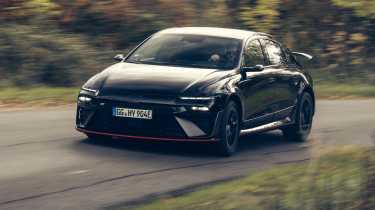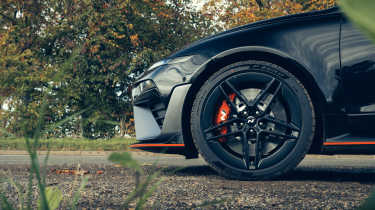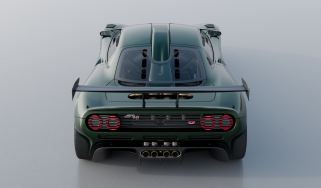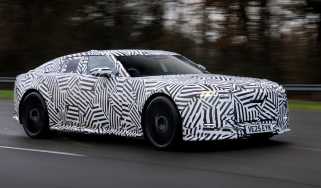Hyundai Ioniq 6 N review – can this performance EV tempt you out of a BMW M3?
Hyundai is following its Ioniq 5 N with the new all-electric Ioniq 6 N borrowing much from the impressive 5 N SUV
A huge name in the game of making electric cars that driving enthusiasts should be paying attention to right now is Hyundai. Its sophomore driver’s EV effort, the Ioniq 6 N, pairs much of the potent hardware and entertaining parlour tricks of the Ioniq 5 N, with a lower saloon car shape, albeit one that’s far from conventional.
It’s lower, wider and more aggressive than the gawky banana-shaped saloon it’s based on, with an almost 911 GT3-esque (functional so says Hyundai) swan-neck wing and a Nissan GT-R-like broad-shouldered stance on the road. But is it a viable performance car alternative to the likes of the BMW M3?
> Hyundai Ioniq 5 N review – proof that electric cars can be fun, not just fast
Though this prototype isn’t exactly like the Ioniq 6 Ns you’ll be able to buy early next year, it’s representative. The biggest difference will be normal mirrors taking the place of these slimmer cameras. Why? The drag saving thanks to the slipperier aero profile of the camera mirror doesn’t cancel out the energy required to keep the cameras de-misted. You’ll laugh (I did) but you have to hand it to them for not persisting with ‘innovation’ and newness for the sake of it.
Other prototype quirks? Customer Ioniq 6 Ns will have two custom modes in which your preferred dynamic settings can be saved and accessed via the two buttons on the wheel, perhaps one for daily driver dawdling and one for B-road blasts. I only had access to one and exploration of the 6 N’s performance and dynamics was the priority.
Sharing its powertrain with the Ioniq 5 N means the 6 N generates 601bhp and 546lb ft in total (641bhp with the ten second boost active deployable via a button on the wheel) split across a motor on each axle with a rear bias. These are fed by an 84kWh battery mounted in the floor of the car. The Ioniq 6 N is stiffer than the standard car thanks to additional spot welds and adhesive use in the structure, a new (bright red) rear strut brace and stiffer underfloor. New adaptive ‘stroke sensing’ dampers and stiffer bushes feature alongside revised geometry for a lower roll centre.
There are numerous ways to configure the exact flavour of Ioniq 6 N you’ll be driving. Power delivery, steering, suspension, e-LSD and stability control are all three-way configurable across normal, sport and sport+ settings, while you also have three choices of synthetic noises – we chose ‘Ignition’, which sounds like an R34 Skyline’s RB26 straight-six filtered through a copy of Gran Turismo 4, as opposed to the more futuristic/sci-fi ‘Evolution’ and ‘Lightspeed’. Vitally important to getting the best out of the 6 N is ‘N E-shift’, which as in the 5 N, gives you eight virtual ratios with ‘revs’ and a ‘power band’, instead of leaving the full potency of the motors available at all times.
Once everything’s set up and you get underway, you notice two things. First, you sit a bit higher than is ideal and it’s more noticeable in the saloon 6 N than in the almost SUV-ish 5 N. The excellent bucket seats are damned by the excess elevation caused by the skateboard platform the 6 N sits on. The whole cabin is nice actually, with tactile physical buttons on the centre console and wheel as well as the usual digital interfaces with clear, attractive and (eventually) intuitive UI.
Second, the 6 N is possessed with more refined and mature damping ability than the feisty, at times too frenetic 5 N. Where you really needed to wind back the toughness in the SUV-hatch for normal driving, the 6 N can almost be driven around in its most aggressive Sport+ mode. Almost. Sudden jolts will rattle your cage and most imperfections are noticeably telegraphed, but these new dampers no doubt go about their business with more considered decorum regardless of setting.
That means you can enjoy the stiffest, most controlled Sport+ setting on the road for more of the time and really work heat into those bespoke HN-branded Pirelli P Zero tyres. And you will, for like the 5 N, there’s a feisty character to the 6 N, a fizz and a tautness identifiable through its controls that gets under your skin and puts your right foot on a hair trigger. It encourages you as the best performance cars do.
Acquiesce to its encouragement and start to push and the 6 N will continue to impress. The performance is obviously ballistic (3.2sec to 62mph with the full 641bhp in N Launch mode), even filtered through the synthetic ‘power band’ and the close ‘gears’ – 62mph from rest with them requires you reach third, no less. I won’t have the gimmick debate here and only insist that you try before you decry – the end result is extra interaction and that is a net positive, however spurious the means.
As the pace builds you can feel the 6 N get up on its toes and its fairly significant mass start to activate underneath you. However there’s not the same familiar build in yaw before grip gives way to slip that you get in ICE cars with a generally higher centre of gravity.
You do learn the 6 N, learn to trust it. Once you do, you can back the car in with neutrality, the car’s mass stroking back and forth on those new dampers with a sense of the available grip coming through your backside and via your internal gyroscope. There are moments when you really do actively enjoy feeling the car’s prodigious vertical control. It’s not shot through with steering feel but the rigidity, response and weight of the rack is nicely judged.
The four-piston (400mm front) brakes are by wire with the car’s brain consistently blending the efforts of the regenerative element and conventional friction elements, to positive effect. You lean on the brakes without paying any mind to their slightly complicated constitution.
It’s a car you can build a natural flow with and enjoy when not fully at the limit. There’s good corner exit adjustability, the e-LSD shuffling power to the outside wheel as you add a glob of throttle and a twist of opposite lock, though as in the 5 N, you get the sense there’s definitely more expression and a more natural feel that could be unlocked here.
It's not a car you dump the power and hit the lock stops, rather you use the rear axle to point the car at pace. The steering gets fizzier and heavier with the sportier modes but isn't laden with real feel. Rather it's razor accurate, working with the eLSD to make the car incredibly pointy and responsive when it's up on its toes. That said, the weight, while very well managed, is there. Patchy wet-and-dry surfaces make the 6 N quite inconsistent, gripping like a mollusc on dry stretches but slipping worryingly early on damp patches, the weight and momentum quickly snatching control. The vertical control is great but horizontally, especially in switchbacks, the sense of mass suddenly becomes very high-definition, as it would to be fair in any heavy car, whether electric, petrol or hybrid – ahem M5.
Indeed this and the Ioniq 6 N’s other flaws will come familiar to those who’ve spent time in its Ioniq 5 N sibling. Electric power simply isn’t as convenient as petrol if you’re looking at spending a few days dissecting the English countryside, even with 350kW charging capability, good for 10 to 80 per cent battery charge in as little as 18 minutes. We saw an indicated 200 miles before we set off, with the number of miles lost ratcheting up much higher than the actual distance we’d traveled for most of our test; it’s claimed the Ioniq 6 N will deliver around 120 miles when driven flat-out on track. It’s also not ideal if you’re hoping for your performance car to retain some of its value, with some 5 N’s dropping a third of the value after just a year of average use.
Like the 5 N and indeed many other performance cars (BMW’s latest M5 springs to mind again), the 6 N is also a car of potentially too many configurable characters – so many that we’ll need more than a chilly autumnal morning to fully explore them. It shouldn’t, after going through all the other custom settings, take digging into the N Drift Optimizer, in which you can adjust initiation, angle and wheelspin via diff, stability and traction control settings to reveal the Ioniq 6 N at its most biddable best.
Nonetheless, buried within and in spite of its weight and the impact on range its performance has should you choose to enjoy it, is a surprisingly engaging, enormously capable performance electric car that we’d challenge anyone to not enjoy time behind the wheel of.
Price and rivals
The full European launch of the Hyundai Ioniq 6 N is set to take place in early 2026 with deliveries beginning shortly thereafter. Prices are yet to be confirmed but we expect it to command a premium over the £65,100 starting point of the 5 N but be comfortably short of, say, the c£89k (before heavy discounts) BMW charges for an M3. BMW’s stalwart sports saloon is probably the 6 N’s closest rival, though like the 5 N, the 6 N is an esoteric thing, without a true direct competitor. You could just as easily cross shop with a BMW i4 M60, or indeed a used Porsche Taycan.
Electric N buyers are a mixed bunch according to Hyundai – people from all sorts of backgrounds, with all sorts of performance car proclivities – but it is happy with the uptake so far. How the Ioniq 6 N will contribute to that, remains to be seen.









